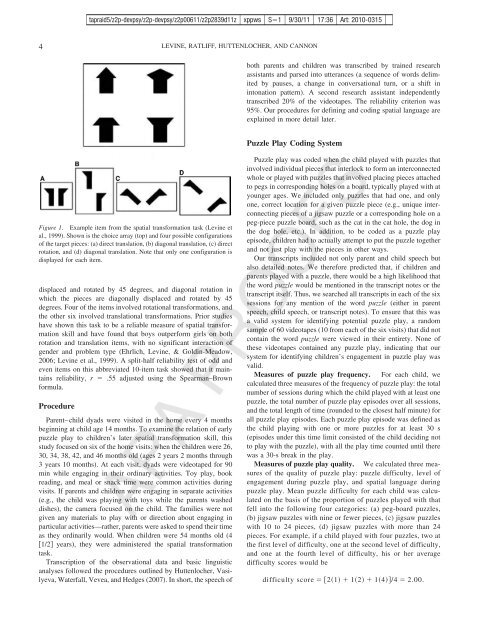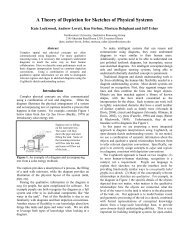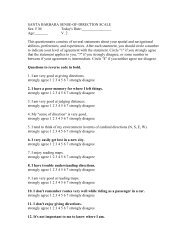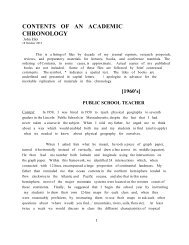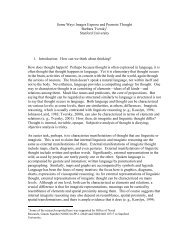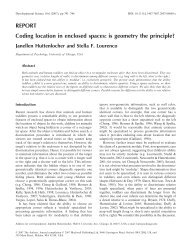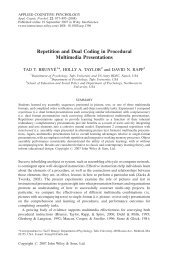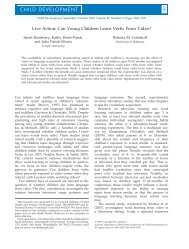Early Puzzle Play: A Predictor of Preschoolers' Spatial ...
Early Puzzle Play: A Predictor of Preschoolers' Spatial ...
Early Puzzle Play: A Predictor of Preschoolers' Spatial ...
You also want an ePaper? Increase the reach of your titles
YUMPU automatically turns print PDFs into web optimized ePapers that Google loves.
tapraid5/z2p-devpsy/z2p-devpsy/z2p00611/z2p2839d11z xppws S1 9/30/11 17:36 Art: 2010-0315<br />
4 LEVINE, RATLIFF, HUTTENLOCHER, AND CANNON<br />
both parents and children was transcribed by trained research<br />
assistants and parsed into utterances (a sequence <strong>of</strong> words delimited<br />
by pauses, a change in conversational turn, or a shift in<br />
intonation pattern). A second research assistant independently<br />
transcribed 20% <strong>of</strong> the videotapes. The reliability criterion was<br />
95%. Our procedures for defining and coding spatial language are<br />
explained in more detail later.<br />
<strong>Puzzle</strong> <strong>Play</strong> Coding System<br />
Figure 1. Example item from the spatial transformation task (Levine et<br />
al., 1999). Shown is the choice array (top) and four possible configurations<br />
<strong>of</strong> the target pieces: (a) direct translation, (b) diagonal translation, (c) direct<br />
rotation, and (d) diagonal translation. Note that only one configuration is<br />
displayed for each item.<br />
displaced and rotated by 45 degrees, and diagonal rotation in<br />
which the pieces are diagonally displaced and rotated by 45<br />
degrees. Four <strong>of</strong> the items involved rotational transformations, and<br />
the other six involved translational transformations. Prior studies<br />
have shown this task to be a reliable measure <strong>of</strong> spatial transformation<br />
skill and have found that boys outperform girls on both<br />
rotation and translation items, with no significant interaction <strong>of</strong><br />
gender and problem type (Ehrlich, Levine, & Goldin-Meadow,<br />
2006; Levine et al., 1999). A split-half reliability test <strong>of</strong> odd and<br />
even items on this abbreviated 10-item task showed that it maintains<br />
reliability, r .55 adjusted using the Spearman–Brown<br />
formula.<br />
Procedure<br />
Parent–child dyads were visited in the home every 4 months<br />
beginning at child age 14 months. To examine the relation <strong>of</strong> early<br />
puzzle play to children’s later spatial transformation skill, this<br />
study focused on six <strong>of</strong> the home visits: when the children were 26,<br />
30, 34, 38, 42, and 46 months old (ages 2 years 2 months through<br />
3 years 10 months). At each visit, dyads were videotaped for 90<br />
min while engaging in their ordinary activities. Toy play, book<br />
reading, and meal or snack time were common activities during<br />
visits. If parents and children were engaging in separate activities<br />
(e.g., the child was playing with toys while the parents washed<br />
dishes), the camera focused on the child. The families were not<br />
given any materials to play with or direction about engaging in<br />
particular activities—rather, parents were asked to spend their time<br />
as they ordinarily would. When children were 54 months old (4<br />
1/2 years), they were administered the spatial transformation<br />
task.<br />
Transcription <strong>of</strong> the observational data and basic linguistic<br />
analyses followed the procedures outlined by Huttenlocher, Vasilyeva,<br />
Waterfall, Vevea, and Hedges (2007). In short, the speech <strong>of</strong><br />
<strong>Puzzle</strong> play was coded when the child played with puzzles that<br />
involved individual pieces that interlock to form an interconnected<br />
whole or played with puzzles that involved placing pieces attached<br />
to pegs in corresponding holes on a board, typically played with at<br />
younger ages. We included only puzzles that had one, and only<br />
one, correct location for a given puzzle piece (e.g., unique interconnecting<br />
pieces <strong>of</strong> a jigsaw puzzle or a corresponding hole on a<br />
peg-piece puzzle board, such as the cat in the cat hole, the dog in<br />
the dog hole, etc.). In addition, to be coded as a puzzle play<br />
episode, children had to actually attempt to put the puzzle together<br />
and not just play with the pieces in other ways.<br />
Our transcripts included not only parent and child speech but<br />
also detailed notes. We therefore predicted that, if children and<br />
parents played with a puzzle, there would be a high likelihood that<br />
the word puzzle would be mentioned in the transcript notes or the<br />
transcript itself. Thus, we searched all transcripts in each <strong>of</strong> the six<br />
sessions for any mention <strong>of</strong> the word puzzle (either in parent<br />
speech, child speech, or transcript notes). To ensure that this was<br />
a valid system for identifying potential puzzle play, a random<br />
sample <strong>of</strong> 60 videotapes (10 from each <strong>of</strong> the six visits) that did not<br />
contain the word puzzle were viewed in their entirety. None <strong>of</strong><br />
these videotapes contained any puzzle play, indicating that our<br />
system for identifying children’s engagement in puzzle play was<br />
valid.<br />
Measures <strong>of</strong> puzzle play frequency. For each child, we<br />
calculated three measures <strong>of</strong> the frequency <strong>of</strong> puzzle play: the total<br />
number <strong>of</strong> sessions during which the child played with at least one<br />
puzzle, the total number <strong>of</strong> puzzle play episodes over all sessions,<br />
and the total length <strong>of</strong> time (rounded to the closest half minute) for<br />
all puzzle play episodes. Each puzzle play episode was defined as<br />
the child playing with one or more puzzles for at least 30 s<br />
(episodes under this time limit consisted <strong>of</strong> the child deciding not<br />
to play with the puzzle), with all the play time counted until there<br />
was a 30-s break in the play.<br />
Measures <strong>of</strong> puzzle play quality. We calculated three measures<br />
<strong>of</strong> the quality <strong>of</strong> puzzle play: puzzle difficulty, level <strong>of</strong><br />
engagement during puzzle play, and spatial language during<br />
puzzle play. Mean puzzle difficulty for each child was calculated<br />
on the basis <strong>of</strong> the proportion <strong>of</strong> puzzles played with that<br />
fell into the following four categories: (a) peg-board puzzles,<br />
(b) jigsaw puzzles with nine or fewer pieces, (c) jigsaw puzzles<br />
with 10 to 24 pieces, (d) jigsaw puzzles with more than 24<br />
pieces. For example, if a child played with four puzzles, two at<br />
the first level <strong>of</strong> difficulty, one at the second level <strong>of</strong> difficulty,<br />
and one at the fourth level <strong>of</strong> difficulty, his or her average<br />
difficulty scores would be<br />
difficulty score 21 12 14/4 2.00.


